Back in 2004, I was looking for a boat to take us to our cabin on Galiano Island, one of the Southern Gulf Islands in British Columbia. We can only get to the cabin by boat, so I needed something that would safely and reliably transport my family of four, our dog, and enough provisions for a week through what are sometimes pretty rough conditions. I was drawn to the Bartender design for its reputation as a capable rough-water hull, for its beautiful lines, and for the fact that it would fit in my garage, which is also my boat shop.
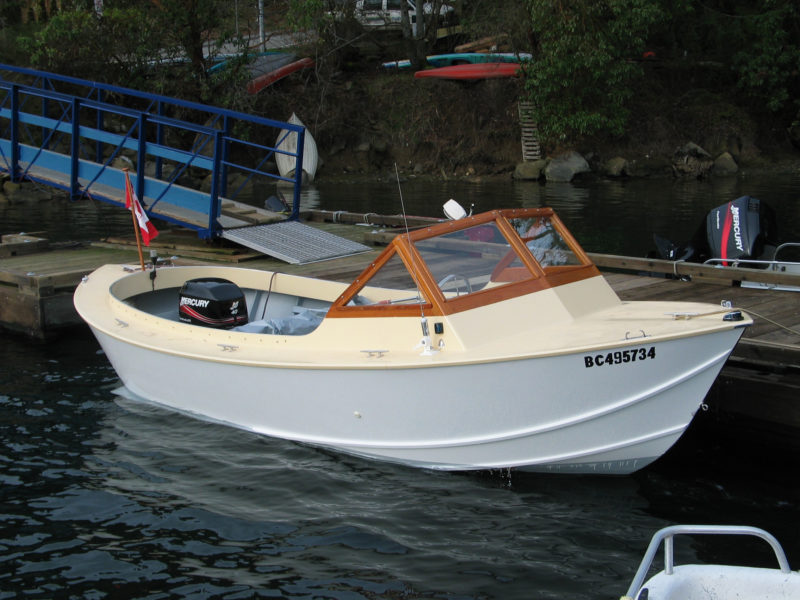 Don Froese
Don FroeseThe guard that rises toward the stemhead is an extension of the planing wing.
The Bartenders, in six models ranging from 19′ to 29′, were designed by George Calkins during the 1950s to negotiate the river bars along the Oregon coast. He died in 2008 at the age of 97. Bill Childs owned the rights to the designs, so we went to visit him in Bellingham, Washington. Bill was kind enough to spend some time with us, answer all of our questions, and show us his cuddy-cabin 22.5-footer and some of the boats under construction in his shop. The Bartenders were even more beautiful up close, and I ended up buying a set of plans for the 19-footer. Plans are available for Bartenders up to 29′, but for me, the best boat is the smallest one that will do the job.
I started building my Bartender in 2005 and it took approximately two years of evenings and weekends to complete. The 19-footer just barely fit in my enclosed one-car garage when it was positioned diagonally. At the time, Bill sold frame kits, and this was a great way to get started. The frames, constructed of 3/4″ meranti plywood, fit together quickly and accurately on the jig.
The only fiberglass called for in the plans was on the bottom for stiffening and to provide a more abrasion-resistant surface for beaching. Standard 8′ plywood sheets were used for the bottom and side panels, and were butt-joined using an overlapping reinforcing piece of plywood, located between frames. The hull was sheathed in 3/8″ meranti attached with epoxy and silicon-bronze screws above the waterline and stainless-steel screws below. Bill strongly emphasized that the Bartender should be lightly built, very close to the plans with few or no modifications, especially those that would increase the weight of the boat or affect the hull shape or balance.
The plywood was coated in epoxy resin below the cockpit sole, and painted with a two-part industrial epoxy paint. This paint was also used on the sole and as a primer on the outside of the boat. The hull was finished off with Pettit EZ-poxy marine paint above the waterline and antifouling paint below. The finish has stood up very well, and has been refinished twice over the ten years the boat has been in the water.
 Don Froese
Don FroeseThe long motorwell and the planing wings are two of the Bartender’s distinctive features.
Two very important features of the design are the planing wings and the motorwell with its plug. The Bartender is a planing-hull boat, and the 19-footer needs the surface area of these essential components in order to plane and handle properly. The motorwell plug is critical to the performance of the boat and must be made to fill as much of the area as possible in the motorwell. The plug is a plywood box-like fixture that has an angled forward face to reduce drag and push water down. It hinges down as the motor is lowered, and then locks in place. Lifting the plug and motor is a two-step process where the motor is lifted partway up, the plug is raised, and then the motor is lifted the rest of the way up. The extra step is unusual, but it allows the plug to be built with as much surface area as possible.
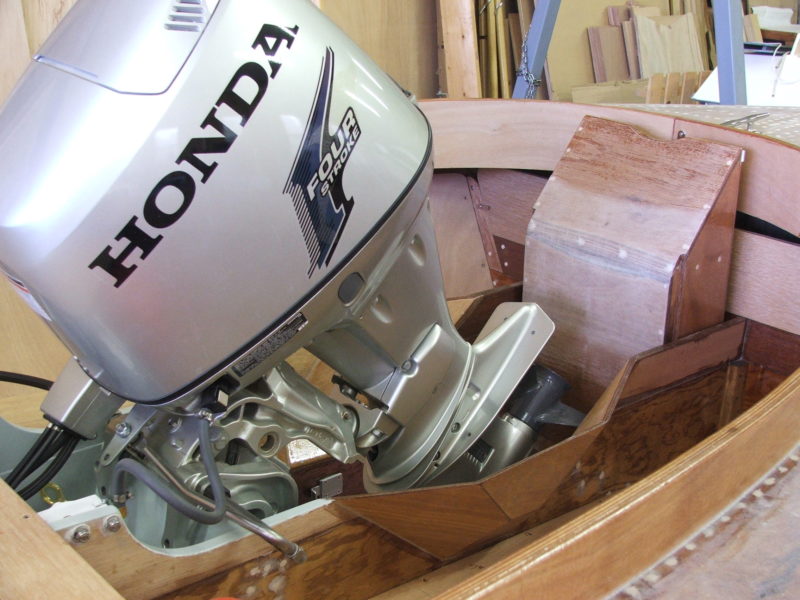 George Costakis
George CostakisFor the motor to tilt up, the plug has to be pivoted to a vertical position. This motorwell has faceted expansions on its sides to provide room for the motor to turn.
Modern four-stroke outboard motors are much larger than the early two-strokes that were prevalent when the Bartender was first designed, and may require that the top of the well be flared outward to accommodate the power head and to allow the motor to turn. This modification to the well is not part of the plans, and its shape will depend on the motor to be used. The newer outboards—especially the four-strokes—are also much heavier, so choosing as small an engine as possible is a good idea. We decided on a four-stroke, 40-hp Mercury outboard. This motor uses the same size block as the 30-hp version and weighs approximately the same; it’s much lighter than the 50-hp, which is the next size up. With the 40-hp outboard the Bartender has a top speed of 25 knots and outstanding fuel economy.
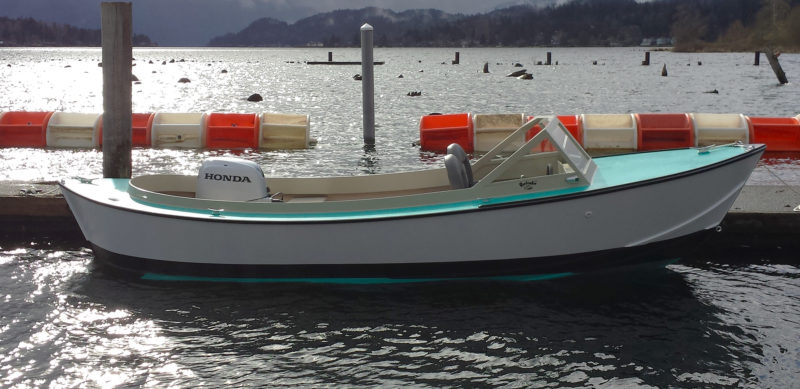 Bill Childs
Bill ChildsThe standard 19′ Bartender has a low windshield built on top of the deck.
The boat was going to be in the water year-round, so it needed to have a self-bailing cockpit. The cockpit sole is elevated above the waterline, and scuppers drain water out through the motorwell. I also installed an electric bilge pump in the sealed compartment beneath the sole to remove water that seeps through seams and access hatches, but I have rarely needed to use it. The plans include details for positive flotation, which consists of blocks of foam glued underneath the fore, aft, and side decks. I also built sealed compartments in the bow and stern to help keep the boat afloat if it ever flooded.
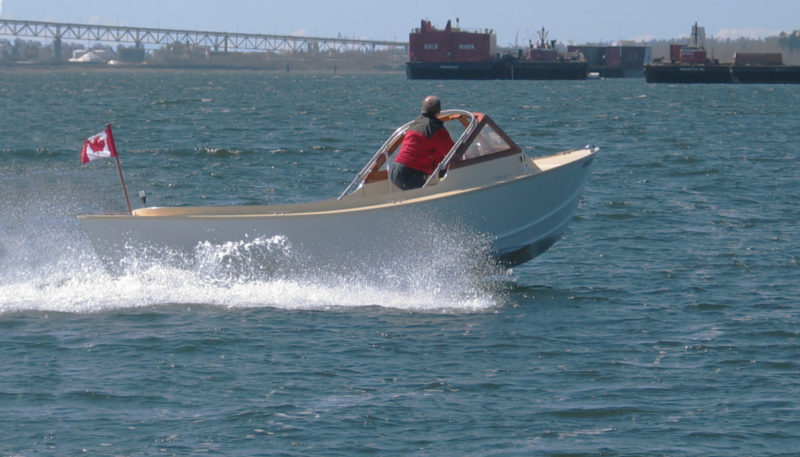 Don Froese
Don FroeseThe author elevated the windshield of his Bartender to provide more protection from the wind.
One aspect of the design that we did modify somewhat was the dashboard/windscreen area. We wanted a bit more protection from the elements. Bill had advised me not to increase the cockpit height too much to avoid problems with windage and weight balance, so we built a 10″-high step on top of the foredeck and attached the wind screen on top. There is plenty of sitting headroom under the dodger and very good protection from spray and rain. We had the dodger sewn up with a zippered panel above the driver’s seat. My usual driving position is sitting on top of the seat back with my head poking out above the top of the wind screen. This is a comfortable position for me and provides very good visibility.
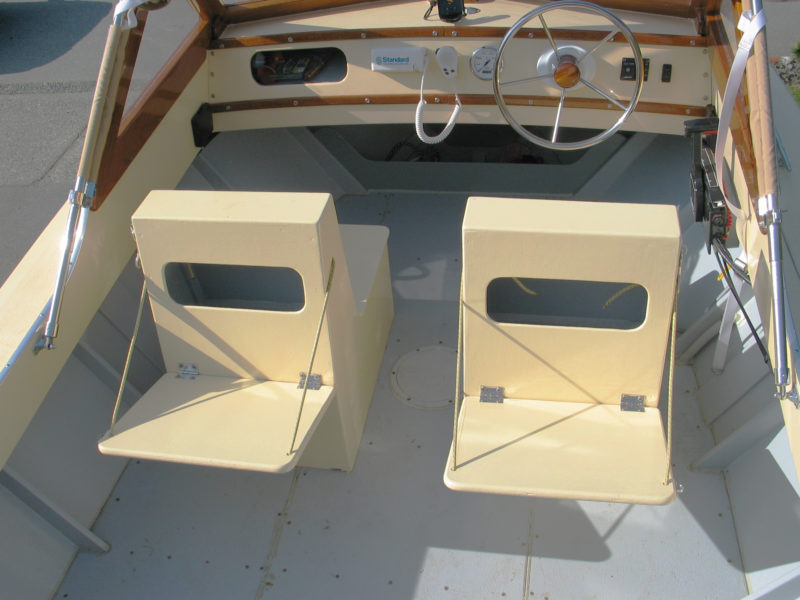 Don Froese
Don FroeseThe author designed and built cockpit seating that conceals the gas tanks. Folding seats face aft for extra passengers.
The seats, which are my own design, are simple plywood boxes with fold-down seats on the rear-facing side that provide access to storage in the backrests. The portable fuel tanks are located under the seats, and the battery is just forward of the motor below the cockpit sole, keeping the weight of those items low and near the middle of the boat.
The boat comes up to plane very easily with the 40-hp motor, thanks to the planing wings. There is no noticeable change from displacement to planing, just a gradual transition as the bow drops a bit and the speed increases. The hull performs very well in both smooth and rough seas. The double-ended stern handles a following sea nicely, easily surfing down the wave faces, and doesn’t get pushed around by waves as transom stern would. Having the motor located close to the center of the boat gives it sharp handling. It likes to carve a turn and tracks very well. The only downside of the motor location comes when we’re towing anything from the stern cleat—it is difficult to turn. This problem would be easily solved with a towing post closer to the motor but has not prevented us from pulling the occasional water skier. The 40-hp outboard is just enough to get a slalom skier out of the water.
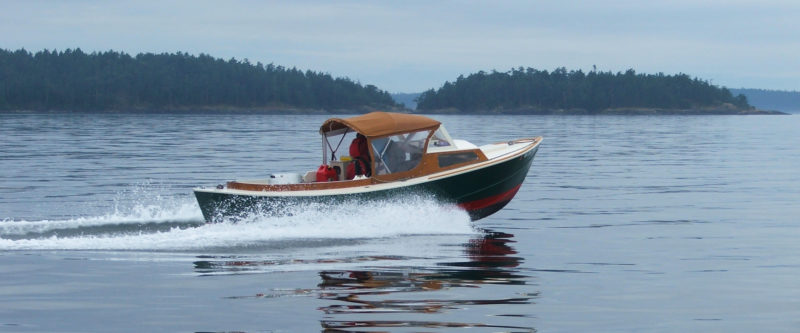 George Costakis
George CostakisA Bartender with another builder-designed modification has a cuddy-cabin roof supporting the windshield.
The Bartender has a generous dory-hull flare, and the beam at the waterline is just 58″. The narrow waterline beam makes the hull quite tender during boarding and very sensitive to weight shifts while under way. Moving around in the boat definitely makes the boat harder to handle, but if passengers stay seated the boat is a lot of fun to drive.
The hull’s flare provides very good secondary stability and handles waves and rough water very well. The only issue I have had is when crossing waves at a shallow angle. If the waves are almost parallel to the boat, the stern can sometimes break loose, causing the boat to spin out. This is easily avoided by approaching waves closer to head-on. The hull has a lot of freeboard, and the combination of flare and spray rails keeps the spray out of the boat.
We have been using our Bartender at least once a month for the last 10 years with very little maintenance and have been very happy with it. It does everything we want it to do and more. There is plenty of space for two adults, two kids, our dog, and all of our supplies. We have used the boat for fishing, water-skiing, and hauling way too much stuff to and from our summer cabin. The plans were very detailed, providing a materials list and all the information required. The building process was straightforward, and the Bartender forum group was a great resource.
The Bartender is a high-performance design that is fun to drive, safe to ride in, and sweet to look at. Ours gets a lot of attention at the dock, and I am surprised how many people recognize it and ask, “Hey, is that a Bartender?” It’s a great feeling to answer, “Yes, and we built it ourselves.”![]()
Don Froese is an electrical engineer living in North Vancouver, B.C. He has built several small kayaks and rowing boats in addition to his 19′ Bartender.
19′ Bartender Particulars
[table]
Length/19′
Length on waterline/16′
Beam/6′8″
Draft/8″
Weight/1,350 lbs
Power/25- to 50-hp outboard
[/table]
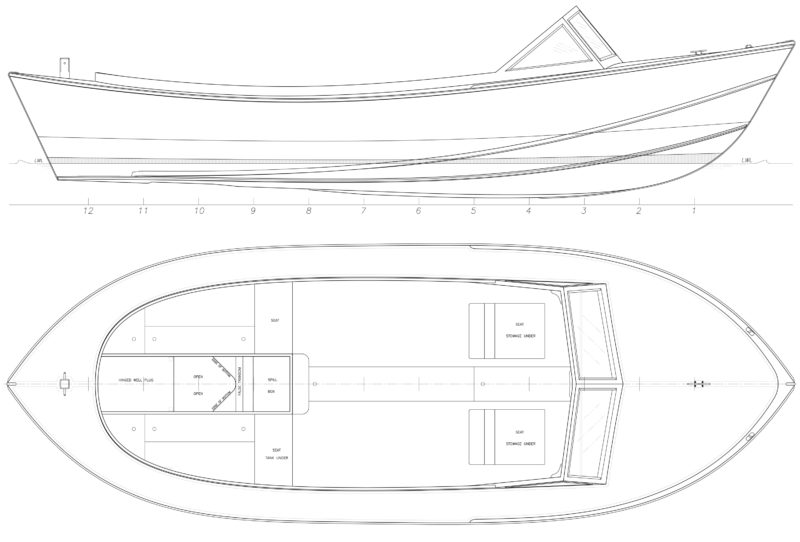
Plans for the 19′ Bartender are available from Bartender Boats for $225. Plans with patterns sell for $325.
Is there a boat you’d like to know more about? Have you built one that you think other Small Boats Monthly readers would enjoy? Please email us!
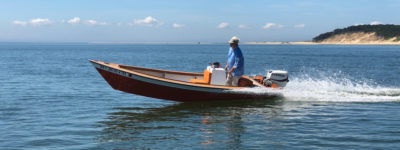
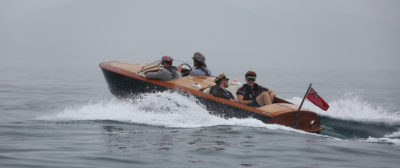
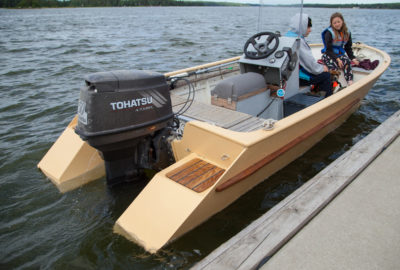

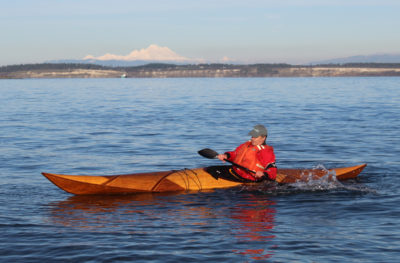

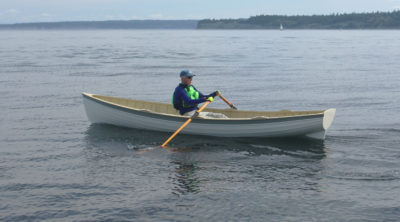
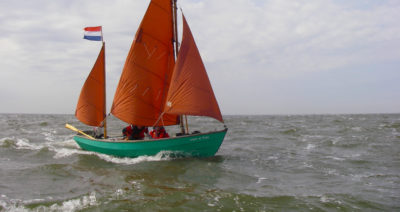
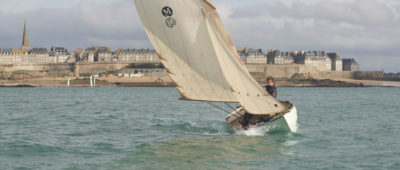
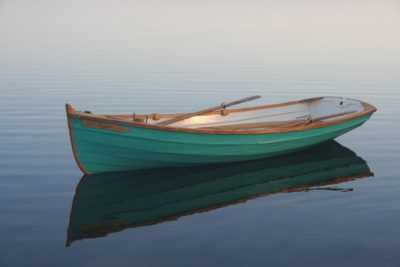
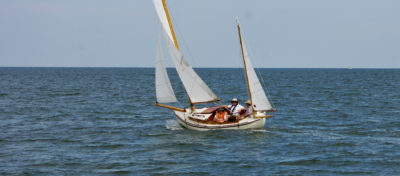
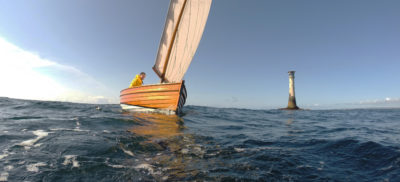
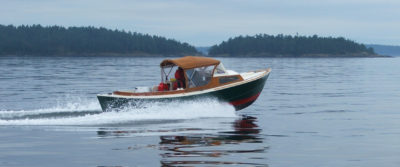

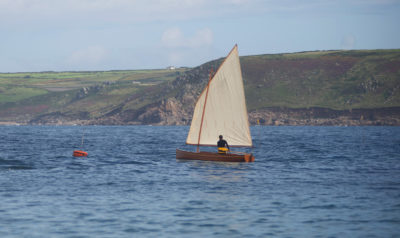
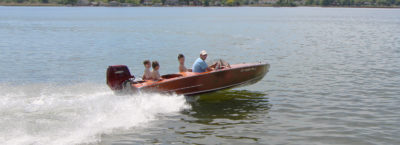
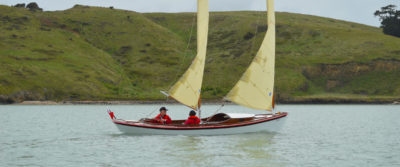
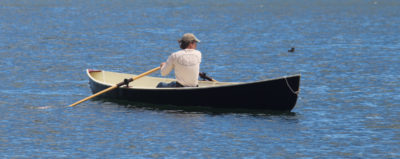
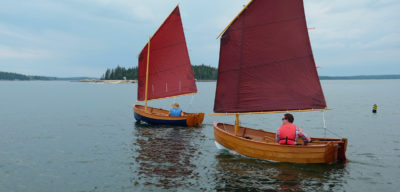
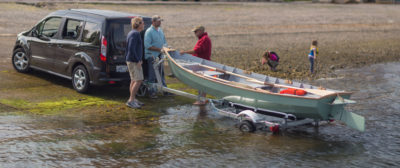
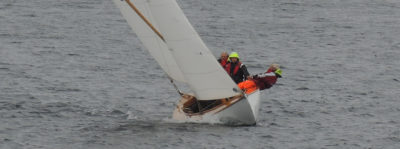

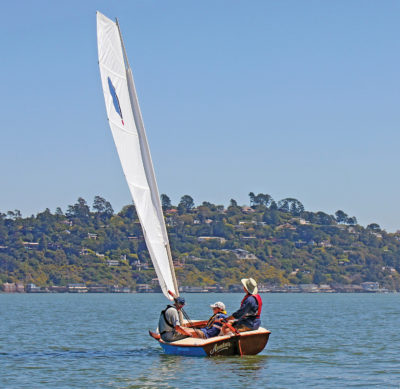
Fantastic boats. I had a 26-footer in the early ’70s and it was clearly better than anything around at the time, and I don’t think anything has changed.
Not much except heavy SLOW to accelerate 4-stroke (joke) outboards.
Do you think one could fit a fifth seat in a 19-footer? I think my father has one that length on a trailer with no motor in Washington State, not far from Bellingham actually (which is kind of neat, having just read here that Bill Childs lives there). Dad’s not using the boat, but I have 3 kids so I’d need 5 seats.
I live in northern Michigan and have been looking for a boat to build that could handle the waters of Lake Michigan and Grand Travers Bay. A trailerable boat would allow me to haul it to many of the areas we now live in. I have built two small kit-style boats and I’m sure I could handle building you 19′ Bar Tender. One question is if two people could sleep aboard the 19′ version. By sleeping aboard I am talking about a couple of air mattresses and lying on the floor on either side of the engine well. To accomplish this, I would need some kind of canvas enclosure that would keep out the weather and mosquitoes. I like the looks of the 19′ version and the relative, straightforward plans. Also, what would be the average, approximate cost to build the boat? I will look forward to your response.
Thanks,
Larry Heitman
Hi Larry,
It is possible to sleep two people on the floor of the 19′ Bartender, but it does depend on how you build out the cockpit area and it will be tight—kind of like two people sleeping in a two-man backpacking tent. If camping in the boat is important, I would make the helm seats removable. They can be stored overnight in the motor-well area. This will open up an area about 6.5′ long, 46″ wide in the helm area and 54″ wide just forward of the motor well.
My 19′ is not setup optimally for camping, but I have done it, sleeping alone. I was able to pitch a small, two-man, self-supporting, backpack tent to sleep in. I had to lay diagonally and there was only enough room for one person. But with the arrangement I described above, I think two can sleep cozily.
The 19′ build cost for materials and basic electronic will be around $9000 not including the outboard or trailer.
Best Regards,
George Costakis
Hi!
You show a 4-stroke Honda in your pictures of a Bartender. Does this outboard work well with the 19′ Bartender and what HP rating does the engine have?
Thanks,
Mark
Hi Mark,
The 19′ Bartender design specifies an outboard range of 25 to 50 hp, while the 40 hp is recommended. There is also an outboard weight limit of 214 lbs.
-cylinder engine. The 25 and 30 hp are based the same engine while the 40 and 50 hp use the same higher displacement base engine. Manufacturers like Yamaha and Mercury combine their engines differently. The 30 and 40-hp outboards use the same 3-cylinder engine, and the 50-hp jumps up to a 4-cylinder engine. This makes the Yamaha and Mercury 50s too heavy for the 19′ limit and it makes the 30-hp outboards heavier than Honda’s. Now, if you are just wanting the recommended 40-hp outboard, then all 3 manufacturers provide a 3-cylinder engine of similar weights.
A couple other advantages of the Honda is typically the plastic shrouding around the powerhead and lower unit is less bulky allowing to it to fix better into the motor well. Also, the Honda has two splash plates above the anti-ventilation plate and exhausts at the propeller.
On my 19′, I have a Mercury 40-hp, 4-stroke outboard, as does Don Froese who wrote the article. I am very happy with mine and it provides plenty of power. If I every re-power my 19′, I will probably consider a Honda 30 hp since top speed is not my primary objective.
Thanks for your question,
George Costakis
Mark,
To answer your last question… The Honda in the photo is either a 40 or 50hp.
George
Thanks, George. Did you need to flare the inboard well for the 40 hp Mercury used in your 19′ Bartender?
Regards,
Mark